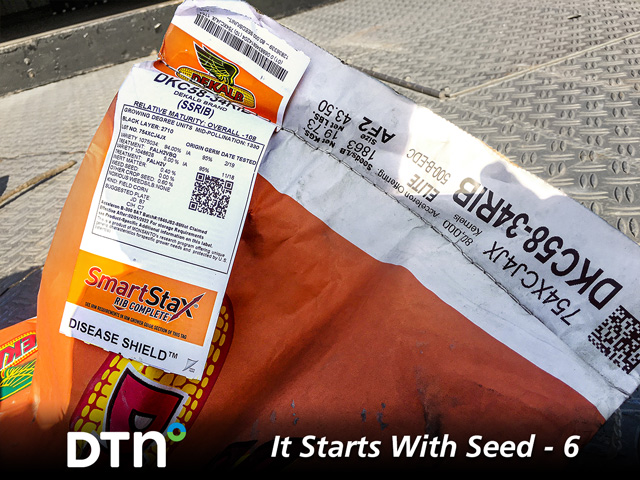It Starts with Seed - 6
Seed Tags List Important Information
Don't be so quick to discard the seed tag that comes with each seed bag or box.
"A lot of people are ordering seed earlier and earlier because of sales incentives," Michigan State University Extension entomologist Chris DiFonzo noted. "If you ordered seed in October, and it got shipped to you in April, that's a long time to try to remember exactly what you ordered. I tell farmers to save at least one seed tag from one bag, throw it on the barn wall with a pin or a nail," she said. "If you have any issues, there it is. If you have no problems, rip it down in the fall."
DTN/Progressive Farmer is running a special series called It Starts With Seed to help farmers start thinking about their seed purchases and preparing for next year. The stories provide insights and information on a wide range of topics. In this, the sixth story of the series, we review the information available on the seed tag that comes with each seed bag or box.
Depending on the company, seed tags may come separately from the seed, University of Wisconsin plant pathologist Damon Smith said. GM traits, germination rates and other seed-specific information are generally listed on one tag called the seed label. Added chemicals, such as seed treatments, can be found on a second tag, which will detail pesticide label requirements.
Here's how to use those labels:
SEED LABELS
-- Variety: Check that you got the cultivar you selected.
-- Trait package: Use this to understand herbicide tolerance, Bt traits or other GM specialty traits purchased. For Bt corn, use the "Handy Bt Trait Table" at https://www.texasinsects.org/… to identify the Bt proteins within the hybrid, pests controlled by the technology, refuge requirements and where resistance is an issue. Bt hybrids will also list any refuge-management requirements on the seed label.
-- Lot number: Use this to report performance problems to the company.
-- Percent germination: This indicates the percent of seed you should expect to see emerge after planting.
-- Germination test date: This shows the most recent germination test and age of the seed. You can ask for a more recent test or have a lab perform one.
-- Percent pure seed and percent other seeds: This details any other crop or weed species seeds that might be mixed into your seed, with a special listing for any noxious weed species.
-- Certified seed classification: This may be listed on a second label, depending on your supplier.
-- Name and address of company: This is who you should call if you have a problem.
P[L1] D[0x0] M[300x250] OOP[F] ADUNIT[] T[]
SEED-TREATMENT LABEL
-- Treatment name: A lot of seed-treatment ingredients are offered under different brands and package names. Sort out which ingredients are coated on your seed with the "What's on Your Seed?" chart by visiting https://ipcm.wisc.edu/….
-- Ingredient list: Look for the chemical names and the rates at which they are applied.
-- Handling requirements: These list any necessary personal protective equipment and handling steps, as well as first-aid suggestions if you get the chemicals on your body or clothes, or ingest them.
-- End-use warning: If the chemicals on the seed are a certain category of toxicity, they will include warnings not to use them for feed, food or oil purposes.
-- Wildlife warning: This warns against leaving treated seed on the ground, where wildlife might consume it.
-- Storage, disposal and container-handling guidance: Since discarded treated seeds are classified as hazardous waste, the label will include instructions on how to store and dispose of small, leftover amounts of product that can't be returned to the company, as well as how to handle used containers and bags.
For more information:
-- Explore the "Handy Bt Trait Table" at https://www.texasinsects.org/….
-- Visit What's on Your Seed?" chart at https://ipcm.wisc.edu/….
**
Editor's Note: This is the sixth of the stories in our special It Starts With Seed series. Next in the series: Question-and-Answer profiles that put faces to leadership within the four companies that dominate the sales of agricultural seeds in the U.S.: BASF, Bayer, Corteva and Syngenta.
You can find earlier stories in this series at:
It Starts With Seed - 1
Crop Breeding Efforts for Climate Extremes
It Starts With Seed - 2
Seed E-Commerce is a Growing Business
It Starts With Seed - 3
Chart Identifies Seed Treatment Products, Active Ingredients
It Starts With Seed - 4
Bt Trait Table for Corn Production Clarifies Insect Traits
It Starts With Seed - 5
Growing Seed Offers Farmers Financial Opportunities
Emily Unglesbee can be reached at Emily.Unglesbee@dtn.com
Follow her on Twitter @Emily_Unglesbee
(c) Copyright 2021 DTN, LLC. All rights reserved.





